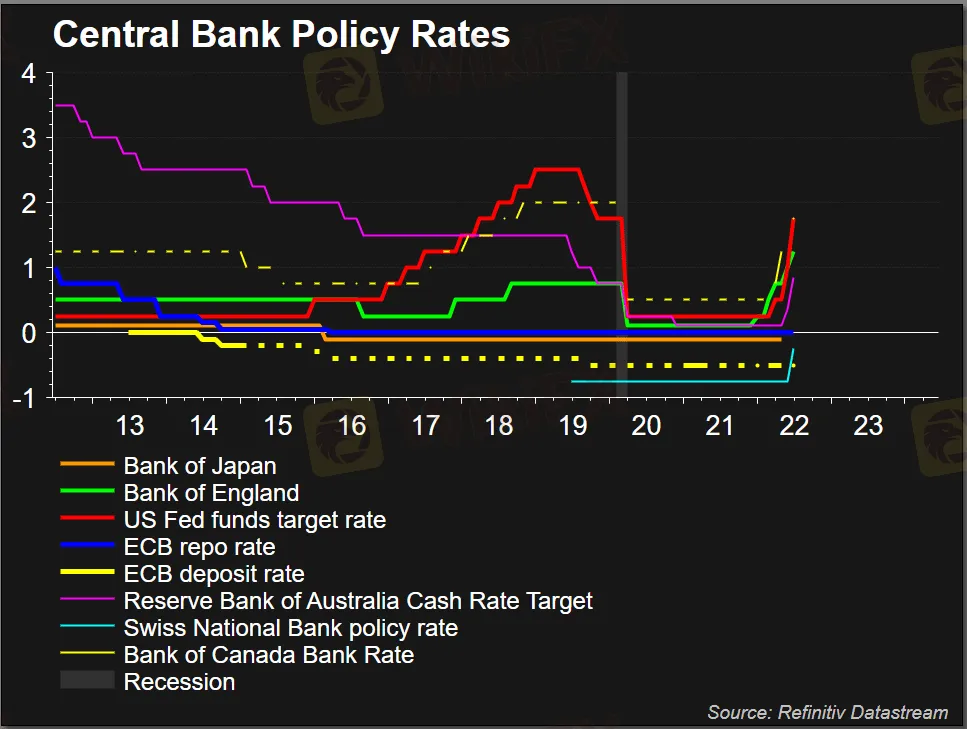简体中文
繁體中文
English
Pусский
日本語
ภาษาไทย
Tiếng Việt
Bahasa Indonesia
Español
हिन्दी
Filippiiniläinen
Français
Deutsch
Português
Türkçe
한국어
العربية
Full force of central banks siphoning world liquidity: Mike Dolan
Abstract:Coordinated or not ahead of this month’s G7 summit, global central banks are accelerating interest rate hikes but also actively draining the giant pool of cash swilling around world markets and buoying currencies to stymie imported inflation.

You dont have to be a strict monetarist or liquidity obsessive to see how the scale of this will affect stocks and bonds over the remainder of the year at least.
For many who do focus on the lockstep impact of world liquidity on asset prices, the process has already been underway since late last year and has been the driver of the 20-30% drop in major stock indices since December.
The worrying bit for investors is that it may only be about half-way through and the aggressive tightening unveiled this week shows little trepidation among policymakers right now.
This weeks headline grabbing interest rate rises from the U.S. Federal Reserve, Bank of England and Swiss National Bank show new-found determination to get across decades high inflation as quickly as possible while unemployment rates are near historic lows and labour markets remain tight.
The European Central Bank grappled with how to rein in ballooning euro sovereign risk premia as it prepares to raise rates next month for the first in more than a decade. But agreement on the “anti-fragmentation” backstop was seen as a quid pro quo for steeper policy rate rises and markets now price almost 2 percentage points of hikes by the year-end.
The Feds outsize 75 basis point rate rise was its biggest move in 28 years, with markets now expecting its key rate to more than double from new target range of 1.50-1.75% within a year. Even grappling with a much weaker economy, the Bank of England is also expect to almost double rates to more than 2% from here.
The shock half-point rise in SNB rates on Thursday threw another log on the fire, leaving a lonely Bank of Japan the only one of the major players still pegging short and long-term borrowing rates down.
Technical recessions may now be an inevitable price to pay. Some argue that allowing inflation to stay so high may trigger one anyway by squeezing real incomes and company margins hard.
But higher central bank borrowing rates are just one part of the story and the great unwind of central bank balance sheets is arguably a far more direct impact on world markets.


Secretly draining
According to liquidity specialists CrossBorderCapital, the annual percentage change in central bank liquidity has already collapsed and is contracting from peak annual expansion rates of about 40% last year.
In note published just before this week‘s barrage of official rate rises, it stressed that this contraction was underway before this month’s start of the Fed‘s “quantitative tightening” (QT) or next month’s ECB equivalent – however messy the latter may be in the light of a new “fragmentation” buster.
And it expected an annual contraction of up to 10% to persist for the next two years.
The Feds contribution to the fabled punchbowl this year is a case in point.
Even though its overall balance sheet brims at well over $8 trillion on the eve of QT, commercial bank reserves held at the Fed – a flipside of balance sheet assets and where the real liquidity to world markets comes from – have dropped by almost $1 trillion since December as U.S. Treasurys account at the Fed refilled.
And thats before some $1-$2 trillion of overall balance sheet reduction comes down the pike over the next 18 months.
Claiming the Fed has been “secretly shrinking liquidity injections” this year, CrossBorderCapital sketches how the confluence of reduced Treasury bill sales and rising Fed rates draws more and more of that money into Fed reverse repurchase operations – currently running at more than $2 trillion nightly.
That further shrinks the “effective Fed balance sheet” and that could now halve by 2025 due the combination of outright balance sheet decline and the draw of reverse repos.
“A rising tide may well float many boats, but a tsunami of monetary tightening unquestionably sinks asset markets,” it concludes.
While this may appear like arcane accounting, the shift in these liquidity measures tallies uncannily with market pricing.
Beyond the Fed, the ECB picture may seem messier. But BoE balance sheet reduction is also due and the SNBs surprise rate hike rates sees it embrace a strong Swiss franc to dampen imported inflation and likely stop its FX-related balance sheet accumulation of global stocks and bonds.
Whats more, the aggressive turn in Fed tightening promises even more dollar strength ahead, forcing other central banks into similar tightening for fear of exaggerating their inflation pictures with ever higher dollar-based energy and food imports as well as tightening borrowing conditions for emerging markets.
“The last decade was a race to the bottom in currency wars globally, with lacklustre inflation dynamics, but the mood music has now changed,” said Charles Hepworth, Investment Director at GAM Investments.

The author is editor-at-large for finance and markets at Reuters News. Any views expressed here are his own

Disclaimer:
The views in this article only represent the author's personal views, and do not constitute investment advice on this platform. This platform does not guarantee the accuracy, completeness and timeliness of the information in the article, and will not be liable for any loss caused by the use of or reliance on the information in the article.
Read more

Silver surges past $33—are you ready for what comes next?
Silver has once again become the center of attention in global financial markets.

171 years! One of this country’s largest crypto-related fraud
A federal court in Brazil has handed down one of the harshest sentences in the country’s history for a crypto-related fraud, jailing three executives of the now-defunct Braiscompany scheme to a combined 171 years behind bars. The case, which saw some 20,000 investors lose approximately R$1.11 billion (about USD 190 million), underscores Brazil’s intensifying crackdown on unregulated cryptocurrency operations

You need to know this if you are losing money in forex trading!
If you’re losing money in forex trading, you’re far from alone: data from major brokers show that approximately 70 % to 80 % of retail Forex traders end up losing money. This article explores the most common reasons behind trading losses and provides actionable strategies to help you turn your losing streak into a learning opportunity rather than a financial drain.

Japan Issues Urgent Warning on $700M Unauthorized Trades
Japan's FSA warns of $700M in unauthorized trades from phishing attacks on brokerage accounts. Cybersecurity threats continue to rise in the country.
WikiFX Broker
Latest News
eXch Exchange to Shut Down on May 1 Following Laundering Allegations
How a Viral TikTok Scam Cost a Retiree Over RM300,000
JT Capital Markets Review
FCA Proposes Simplifying Investment Cost Disclosure for Retail Investors
Fresh Look, Same Trust – INGOT Brokers Rebrands its Website
FCA Issues Alerts Against Unauthorised and Clone Firms in the UK
Consob Orders Blackout of 9 Fraudulent Financial Websites
Tradu Joins TradingView for Seamless CFD and Forex Trading
Japan Issues Urgent Warning on $700M Unauthorized Trades
Silver surges past $33—are you ready for what comes next?
Currency Calculator


